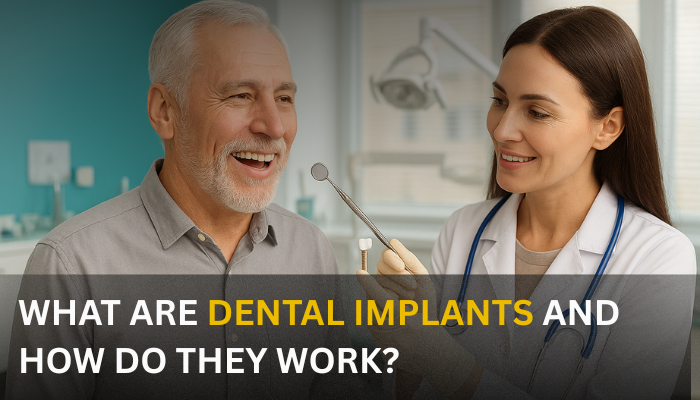We lost a tooth and felt it right away. Chewing became harder. Speaking sounded different. We noticed the empty space when we smiled. We wanted something that felt like our own tooth again. That is why we looked into dental implants. From our first talk with the dentist we learned that dental implants are a stable choice for many people. They replace missing teeth and give us back normal life.
What dental implants are

A dental implant is a small screw that acts like a tooth root. It is usually made from titanium or ceramic. The dentist places the screw into the jawbone. Dental implants replace both root and tooth so the jaw keeps its shape. After the bone heals, a connector called an abutment is fixed. Then the crown is attached. The whole setup looks and works like a real tooth.
We chose implants because they feel steady. For some who need a full mouth solution, implants can hold many teeth or support a denture. A dental bridge can also be fixed using implants when several teeth are missing. In India many clinics use a simple PPT to explain the parts and steps so we understand the plan.
When we consider implants
The implants come to the mind when we lose a tooth either through injury, decay or gum disease. Loss of teeth may alter our chewing pattern and appearance on the face. Implants are helpful in case of pain during chewing or when speech is altered. But we must have healthy gums and enough bone for the screw to hold. If the bone is weak, the dentist may do grafting first to build it up.
The main parts of an implant

Implant body
This is the screw placed into the bone. It becomes the new root and holds the rest steady.
Abutment
This is the small connector above the gum. It joins the screw to the crown.
Crown
This is the visible tooth. It is shaped to match our other teeth. The crown can be ceramic so it looks natural.
Knowing each part makes the process easier for us to follow at the clinic or centre.
Types of implants
Most implants go into the bone. These are called endosteal implants. If bone height is low, a subperiosteal option sits under the gum but above the bone. Dentists pick the best material for each case. Titanium bonds well with bone. Ceramic is a good metal-free choice for some patients.
The step-by-step procedure

We went through the procedure in stages, not all at once:
- Assessment: The dentist takes X-rays to check bone and gums.
- Preparation: If needed, bone grafting is done to strengthen the area.
- Surgery: The implant screw is placed into the jaw.
- Healing: Over weeks the bone grows around the implant in osseointegration.
- Restoration: The abutment and crown or a dental bridge are attached.
If several teeth are missing, the dentist may fit a bridge or denture supported by implants. Some clinics offer a free consultation to explain the timeline and costs. We planned the work with our family so everyone knew the steps.
How implants join with the bone
Osseointegration is the medical name for how bone grows around the implant. The bone locks the screw tightly, so the implant feels like a natural root. That firm hold is why dental implants do not move like dentures. With steady care they can last many years.
Benefits we saw

Our before and after change was clear. The new teeth looked natural. We could chew better and speak more clearly. The implants helped keep the jawbone from shrinking. They did not affect nearby teeth. Unlike some options that rely on neighbor teeth, implants stand on their own.
Many families call dental implants the best long-term choice. For a full mouth restoration they give strength and comfort that few other options match.
Risks and things to watch
No treatment is risk free. Infection around the implant, damage to adjacent teeth or vessels, or nerve pains can be some of the problems. An implant is prone to collapse, often when one has poor oral hygiene or underlying ailments. Failed work rates may be more common with smokers. In case, bone is weak, additional surgery or measures might be required. Our dentist informed us on these risks prior to the commencement of treatment.
Aftercare and long-term care

Caring for implants is simple but important. We brush and floss daily and pay attention to the implant area. We visit the clinic for regular checkups and cleanings. We avoid very hard foods while healing. If anything feels loose or painful we contact the center right away. Good daily care helps implants last for decades.
Conclusion
Dental implants restore what we lost. They fix function and appearance in a way that feels natural. From the first visit to the final crown the steps are clear. With the right material, skilled surgery, and steady care, dental implants can change the before and after of our smile. They are one of the best treatment options available in India for missing teeth. If we want a lasting solution, dental implants are worth considering.
Get the best quality dental implants with trusted materials and expert care at Dhruve Dentofix.
FAQs
Q.What are dental implants?
Dental implants are artificial tooth roots made of titanium or ceramic. Dentists place them in the jaw to hold crowns, bridges, or dentures so we can chew, speak, and smile naturally again.
Q.What are the reasons not to get dental implants?
We should avoid dental implants if our jaw bone is weak, gums are infected, diabetes is uncontrolled, or we smoke. High cost, surgery risks, or slow healing can also rule implants out.
Q.Are there any alternatives to dental implants?
Yes. Dental bridges, removable dentures, and resin-bonded bridges replace teeth without surgery. They are simpler but do not keep the jawbone healthy the way dental implants do over time.
Q.are dental implants painful?
Dental implants surgery is done under anaesthesia that makes us have little or no pain when the surgery is done. Subsequently we can experience soreness or swelling in just a few days. It typically resolves in an 1 week period.










